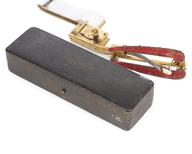





Babinski's reflex hammer, metal disc with rubber ring and metal stem, no maker marked, English(?), first half of 20th century
Hammers like this one are used to test how quickly the muscles and nerves respond to an external stimulus. The hammer is tapped at the knee and the knee jerk response is watched. Injuries to the central nervous system and spine above the femoral nerve (in the hip) cause the knee jerk action to be increased more than normal. Injuries below the femoral nerve cause the knee jerk action to disappear. This was used to pinpoint where an injury had taken place. This type of reflex hammer is named after its inventor, French neurologist, Joseph Babiński (1857-1932).
Details
- Category:
- Clinical Diagnosis
- Object Number:
- 1980-641
- Measurements:
-
overall: 51 mm x 236 mm .155 kg
- type:
- reflex hammer
- credit:
- Hunt, T.




